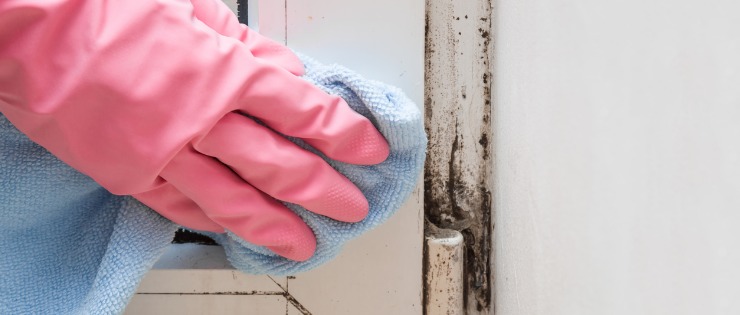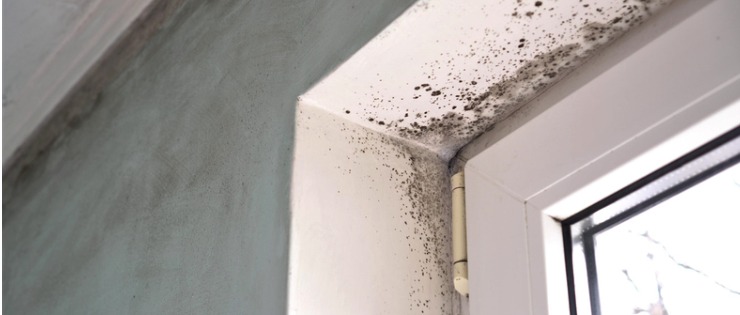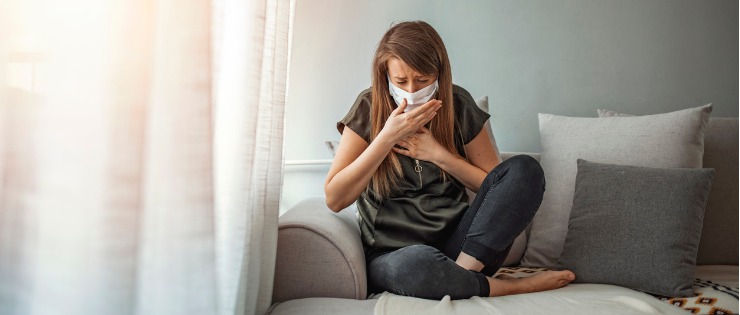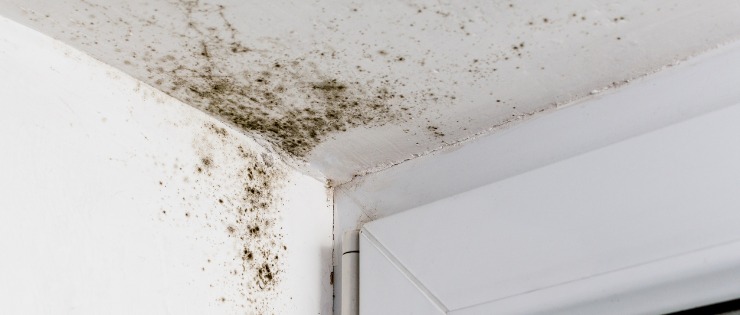
Mould might be unsightly, but the biggest concern for most people is the health problems it can cause. Homes with dampness and mould could make its occupants sick. Often they don’t even know mould is causing their illness.
Mould isn’t easy to detect and can be very difficult to treat. Prolonged exposure to mould can cause respiratory illnesses and chronic health problems.
Here’s how you can spot the signs of mould in your home and what you can do about it, so it doesn’t impact the health of your family.
What is Mould?
Mould is the unscientific name for fungi that appear as patches of black, brown, yellow, green or pink growths. Active mould needs moisture, either excessive dampness or water, to survive.
Fungi reproduces via spores which spread through the air before landing and surviving on surfaces. Different mould spores thrive on different surfaces. Spores vary with the season, weather and location.

Mould in the Home
The problem with mould is its versatility and survival rate. It can enter the home from outside attached to our clothes, shoes, bags or pets.
Or it can begin in the home. Anywhere that has moisture, mould can thrive. Mould can grow on clothes, shoes, paper, cardboard, tiles, wallpaper, paint, carpet and furniture – most surfaces in your house.

Indoor Air Quality
In 2009 The World Health Organisation (WHO) published a report called Indoor Air Quality: Dampness and Mould. It estimated that 10-50% of indoor environments in Europe, North America, Australia, India and Japan have clinically significant mould problems.
The indicators of dampness and microbial growth include:
- Condensation on surfaces and structures such as windows
- Visible mould, especially black mould
- Perceived mouldy odour
- Poor maintenance of air conditioners
- Water damage
More Than Mould is to Blame
Indoor environments include a mix of live and dead microorganisms, toxins, allergens, compounds and chemicals that can make us sick.
In damp homes, mould may be only one of several problems that cause respiratory illnesses. Damp homes are more likely to have more of the following problems than dry environments:
- Bacteria
- Dust mites
- Release of chemicals and particles from damp building materials
- Airborne chemicals
- Virus survival
- Proliferation of rodents and cockroaches carrying infectious organisms
Research has found that exposure to mould and dampness increases the risk of allergy to other allergens such as dust mites and pollen, not just fungi.
Sick Building Syndrome
In 2006, a WHO working group concluded that individual species of microbes and biological agents responsible for health effects can’t be identified. But the only conditions that can be proved with enough evidence to be blamed on a damp building are respiratory related.
‘Sick building syndrome (SBS)’ has been a controversial condition for many years because its symptoms mimic other conditions and affects everyone differently.
People living or working in the same building may have no symptoms while others can suffer acute symptoms. It’s not just fungus and mould that can cause SBS, the following can also be to blame:
- Poor ventilation and lighting
- High dust levels
- Tobacco smoke
- Formaldehyde in wooden furniture and floors
- Asbestos
- Chemicals from cleaning products
- Pesticides
- Insect and animal droppings
- Heat or low humidity
- Carbon monoxide
If ‘sick building syndrome’ symptoms are prevalent, treatment may include more regular cleaning with products that have low fumes or fragrance, vacuuming to remove dust, testing for mould and fungi, improving the humidity and cleaning air filters in air conditioners. Opening the windows and taking regular breaks outside the building can help sufferers reduce their symptoms.
How Can Mould Affect Your Health?
There is some disagreement amongst scientists about the health effects of indoor mould, but most agree that exposure contributes to upper respiratory tract symptoms in some people. These symptoms of mould exposure include a cough, wheeze, nasal congestion, sneeze, asthma, sinus conditions, infections and allergic conditions.

Illnesses Mould Causes
Despite the disagreement surrounding the effects of mould, some believe indoor mould can cause health problems for people of any age group but most at risk are those with a weakened immune system and allergies, young children and the elderly.
Mould is also thought to cause:
- Severe Asthma
- Mood changes
- Aches and pains
- Skin irritations
- Memory loss
- Nosebleeds
- Weakened immune system
- Chronic, obstructive or allergic lung disease
Researchers reviewed 33 studies to assess the risk of health effects in people who spent time in damp mouldy environments. They found upper respiratory tract symptoms were more common. Another review found new onset asthma increased amongst employees working in a water damaged office building. They concluded that if an adult suffers asthma for the first time and mould is present in their home or workplace, it’s likely the mould is to blame.
Mould releases mycotoxins which are toxic substances produced by fungus. Some believe there is no scientific evidence to suggest there are links between health problems and living in buildings with toxic black mould. This dispels the thinking that toxic black mould is dangerous and can cause serious health conditions.
How to Identify Mould and Dampness in the Home
If you see or smell mould, you must have it removed immediately. The longer it stays, the more time it has to grow and cause damage. Some cases of mould are easy to detect, but others can be more difficult.
Difficult to Detect Mould and Damp
The problem with mould and dampness is it can lurk undetected in a home for many months before anyone notices. Some mould is hidden because it loves dark areas.
You may pull the lounge away from the wall and notice they’re both covered in mould or your wall is damp. Most walk-in closets get little natural light so when you pull out a pair of old shoes from the back, you may notice mould. A bathroom shower may leak for many months before the wall on the opposite side is soaked and the water damage appears.
Unsightly Mould
The easiest way to identify mould is seeing its ugly spots of black, brown or green mould appearing in areas of the house that are susceptible including under sinks and in the corners of ceilings.

Smell of Mould
Some people will notice an unpleasant smell of mould before they see where the mould is hiding. As mould multiplies, it releases Microbial Volatile Organic Compounds (MVOC).
Different types of mould produce different odours. Mould odours have been described as musty, wet socks, earthy, meaty, camphor-like, herbaceous or nutty. Unlike other odours in a home, mould is persistent, and the smell doesn’t fade; however, occupants can become accustomed to the smell and not notice it.
Damp to Touch
Rubbing your hand over a wall can give you a good indication of whether the wall is damp or not. A moisture meter is an instrument used to identify water leaks and damage to buildings caused by moisture build-up.
How to Control Mould Around the Home
Even if you don’t think mould is causing any of the household occupants any illness, you want to remove mould because it can ruin furnishings, personal effects and even compromise the structural integrity of the house.
But it’s not as easy to remove as you might hope. Just when you think you’ve rid the house of all signs of mould, it creeps back in months later.
Increase the Ventilation
Mould loves winter because we’re more inclined to keep doors and windows closed which reduces ventilation. The humid air builds up providing the right conditions for mould. Even if the outside air is cold, it’s a good idea to open up the house regularly to get some fresh air in.
Cluttered areas of your house can attract mould. Piles of unused books and papers and overstuffed wardrobes means poor air circulation and an increased chance of mould growing in these areas.

In winter, try to throw out anything you don’t need that can contribute to mould. Less clutter will also make it easier to clean and identify any signs of mould or damp sooner. Check unworn shoes and clothes in wardrobes for any sign of mildew or mould.
Reduce Moist Air
When you shower, either open the window or turn on the extraction fans so it removes the moist air. But keep the bathroom door closed so it contains the moist air to the bathroom and it doesn’t move to other rooms of the house.
In winter it’s tempting to dry clothes inside the house, but the added moisture can invite mould. Try drying clothes under cover outdoors or use a tumble dryer and open the laundry door while it’s in use.
Using a dehumidifier can reduce humidity levels in the house. Reduced humidity can stop mould, mildew and dust mites and help allergy sufferers. The ideal humidity level is less than 50%.
Reducing the Chance of Mould and Mildew Appearing
There are some hotspots in the home that attract mould and mildew more often than other areas.
Carpets & Bedding
Mould loves carpet and rugs so keep them vacuumed and professionally cleaned one a year. If the carpet smells musty check underneath for any sign of mould.
If soaked carpet and underlay can’t be dried out within 24-48 hours, pull them up and replace.
Dispose of any mattresses or pillows that are soaked and can’t be dried quickly. It’s impossible to know if the inside of these products is harbouring mould.
Wet Areas
When it comes time to repaint wet areas like the bathroom and laundry, use mould inhibitors in the paint you use on the walls and ceilings.
Use mould killing cleaning products when cleaning the shower and keep up with weekly cleaning. If you see any sign of damp or mould, treat it quickly.
Furnishings
Look behind large pieces of furniture regularly to check mould isn’t hiding on walls or the back of your furniture. Remove all items from walk-in robes to dust, declutter and check for signs of mildew or mould.
Cleaning and Removing Mould
It’s a job no one enjoys, but the sooner you can treat an area that’s affected by mould, the easier it will be.

Using Bleach to Kill Mould
Most people reach for the bleach as soon as they see mould. It’s a cheap and easy fix most times.
If you use bleach to clean mould, follow these basic tips to stay safe.
- Open windows and doors to keep the room ventilated
- Wear non-porous gloves and eye protection
- Don’t mix bleach with ammonia or any other cleaning products as it may cause toxic fumes
- Read and follow the manufacturer’s instructions
There are also commercial mould cleaners available from supermarkets and hardware stores.
Natural Mould Cleaners
If you prefer to use more natural alternatives, try white wine vinegar. It’s cheap and readily available in the supermarket. Decant it into a spray bottle, spray the surface and scrub with a brush or sponge.
Clove essential oil has mould killing benefits and can be added to the vinegar spray bottle. You can use your vinegar spray as part of your weekly regime to clean the bathroom and prevent mould from returning.
Professional Help
If you have tried to clean mould and it has returned more than once, it may be time to call in the experts to evaluate, clean and prevent it coming back. They have equipment that allows them to measure moisture levels around the house and also ‘see inside a wall’ to better evaluate the severity of the problem and find a permanent solution.